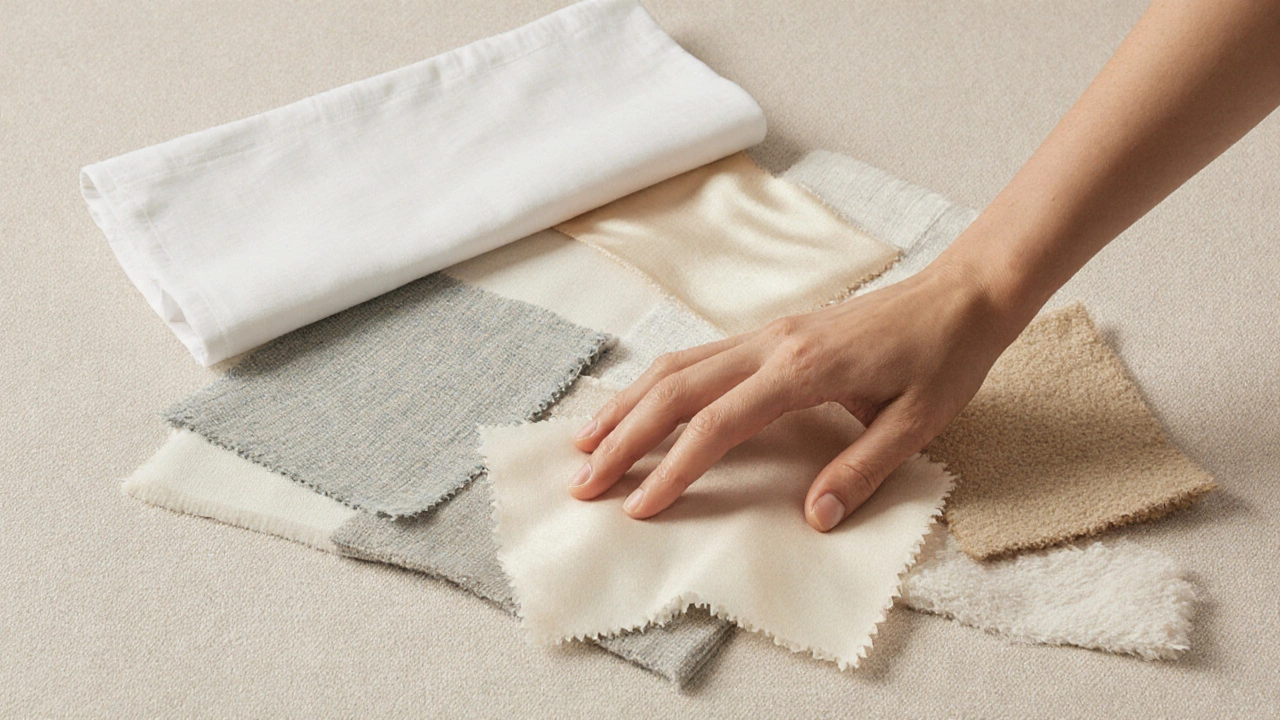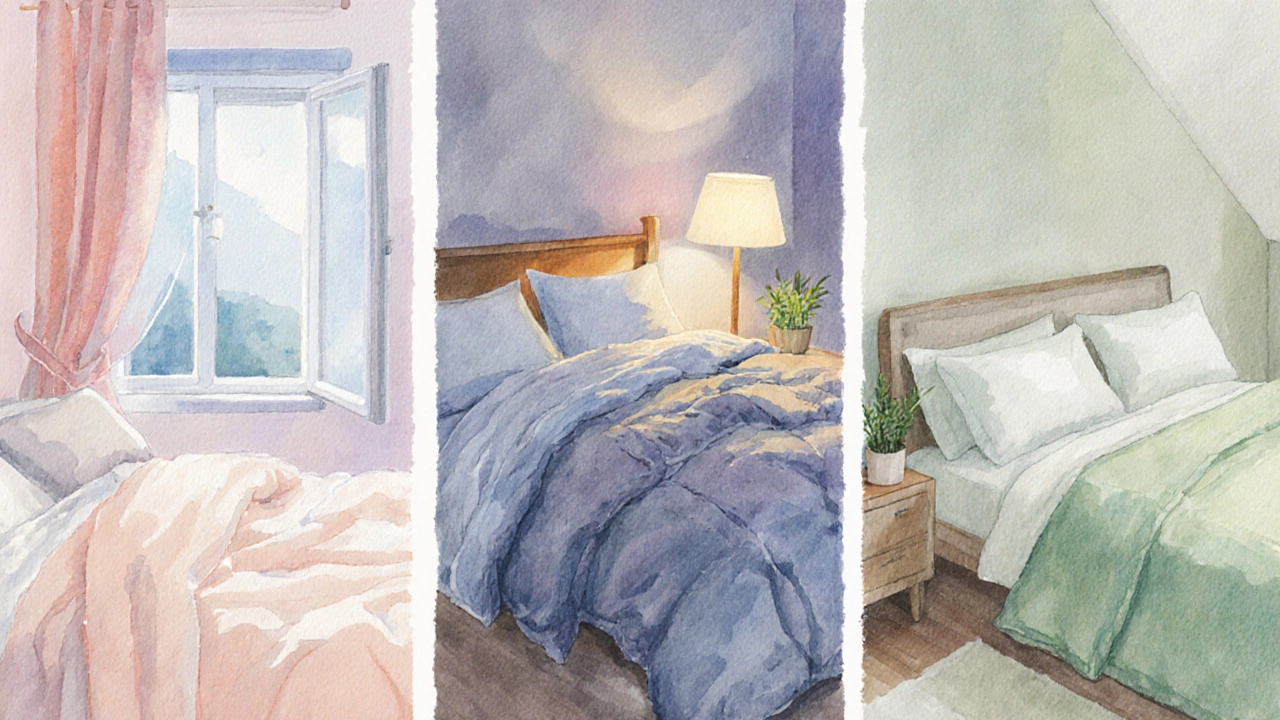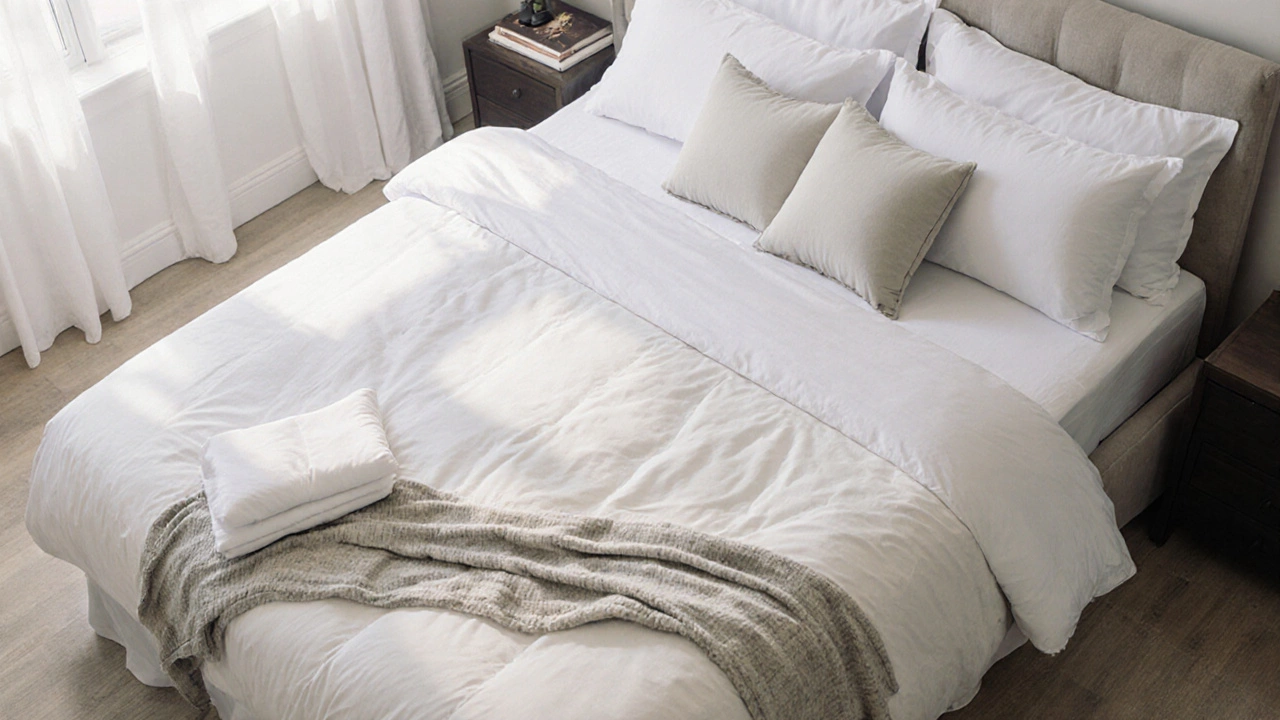Bedding Selector Tool
Select Your Sleep Style
Preferred Material
Bedding Components
This tool helps identify essential bedding components based on your sleep style and preferences.
Key components include: Sheet, Pillowcase, Duvet, Blanket, Mattress Cover, Bedspread, Shams, Bed Skirt.
Material Comparison Table
| Fabric | Feel | Breathability | Durability | Price Range |
|---|---|---|---|---|
| Cotton (Egyptian) | Soft, slightly crisp | High | Very high | £8–£15 |
| Linen | Cool, textured | Excellent | High | £12–£20 |
| Microfiber | Smooth, slick | Moderate | Good | £5–£10 |
| Silk | Luxuriously smooth | Very high | Medium | £15–£30 |
| Bamboo | Soft, slightly silky | High | Good | £10–£18 |
| Flannel | Warm, brushed | Low | Good | £6–£12 |
Recommended Bedding Set
Select your sleep style and preferred material to get personalized recommendations.
Bedding is a collective term for everything that dresses a bed, from the sheets you curl up in to the decorative layers that finish the look. Knowing exactly what falls under the bedding umbrella helps you shop smarter, match styles, and keep your sleep surface in top shape.
What Counts as Bedding?
Most people think of just a sheet set, but the category is broader. Below is a quick rundown of the core pieces that make up a complete bedding system:
- Sheet the flat or fitted fabric that lies directly on the mattress
- Pillowcase a removable cover that protects the pillow and adds a touch of style
- Duvet a soft, insulated insert that provides the main source of warmth
- Blanket an extra layer for added warmth, often used on top of the duvet
- Mattress Cover a protective barrier that shields the mattress from spills and wear
- Bedspread a decorative, lightweight covering that drapes over the entire bed
- Shams decorative pillow covers that coordinate with the duvet or blanket
- Bed Skirt fabric that hangs from the mattress to hide the box spring and storage underneath
Adding any of these pieces changes the look, feel, and performance of your sleep environment.
Common Bedding Materials and Their Traits
Material choice drives comfort, durability, and price. Below is a side‑by‑side look at the most popular fabrics.
| Fabric | Feel | Breathability | Durability | Typical Price Range (per sqft) |
|---|---|---|---|---|
| Cotton (Egyptian) | Soft, slightly crisp | High | Very high | £8‑£15 |
| Linen | Cool, textured | Excellent | High | £12‑£20 |
| Microfiber | Smooth, slick | Moderate | Good | £5‑£10 |
| Silk | Luxuriously smooth | Very high | Medium | £15‑£30 |
| Bamboo | Soft, slightly silky | High | Good | £10‑£18 |
| Flannel | Warm, brushed | Low | Good | £6‑£12 |
When you compare these fabrics, think about the season you’ll use them most, any skin sensitivities, and how often you’re willing to replace them.

Choosing the Right Bedding for Your Sleep Style
Everyone’s sleep habits differ. Here’s a quick guide to match bedding basics to common preferences:
- Hot sleepers - opt for breathable cotton or linen, keep the weave open, and skip heavy blankets.
- Cold sleepers - a flannel sheet set paired with a high‑loft duvet or a weighted blanket works wonders.
- Allergy‑prone sleepers - consider hypoallergenic microfiber or bamboo, and use dust‑mite‑proof mattress covers.
- Eco‑conscious buyers - organic cotton, Tencel derived from eucalyptus, or certified bamboo provide a greener footprint.
Don’t forget the practical side: a fitted sheet that matches your mattress depth prevents bunching, while a duvet with a removable cover simplifies cleaning.
Care and Maintenance Tips
Proper upkeep extends the life of every bedding component. Follow these habits:
- Wash sheets in warm water (40°C) the first few weeks to remove excess sizing.
- Separate colors: whites, lights, and darks should stay apart to avoid bleeding.
- Use a gentle, low‑suds detergent - harsh chemicals can strip fibers.
- Skip fabric softeners on microfiber; they can leave a greasy residue.
- Dry on a low‑heat setting or line‑dry to prevent shrinkage, especially for cotton and linen.
- Iron cotton sheets while slightly damp for a crisp look; silk and linen benefit from a low‑heat press.
- Rotate your mattress cover and duvet insert every few months to distribute wear evenly.
Spot‑treat stains with a mixture of water and mild vinegar before tossing the item in the wash. A quick tumble before it sets can save you a costly replacement.

Budget and Sustainability Considerations
Quality doesn’t always mean pricey. Look for sales on high‑thread‑count cotton when it’s out of season, or buy a “core” sheet set and add decorative shams later. Sustainability can be a savings tool too - many manufacturers now offer bulk‑packed organic cotton that costs less per yard than boutique brands.
Keep an eye on certifications like GOTS (Global Organic Textile Standard) or Oeko‑Tex, which ensure low chemical usage and better durability.
Frequently Asked Questions
Is a duvet the same as a comforter?
Not exactly. A duvet is an insert that usually requires a removable cover, while a comforter is a stitched, ready‑to‑use blanket. Duvets let you switch covers for style or season; comforters are more of a set‑and‑forget option.
How often should I replace my sheets?
For most cotton or linen sheets, a lifespan of three to five years is typical if you follow proper care. Low‑quality microfiber may need replacing sooner, especially if you notice thinning or pilling.
Can I mix different fabrics in one bedding set?
Yes, mixing fabrics is common. Pair a breathable cotton sheet with a flannel blanket for winter, or add a silk pillowcase for hair health while keeping the rest of the set cotton.
What’s the difference between a fitted sheet and a flat sheet?
A fitted sheet has elastic edges that hug the mattress, preventing slips. A flat sheet lies on top of the fitted sheet and can be folded at the foot of the bed for a crisp finish.
Are bamboo sheets really eco‑friendly?
Bamboo grows quickly and requires less water than cotton, making it a greener choice. However, the processing chemicals matter - look for “closed‑loop” or “organic bamboo” certifications to ensure minimal environmental impact.
